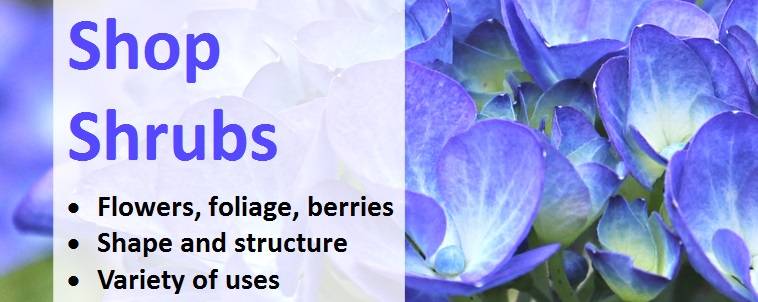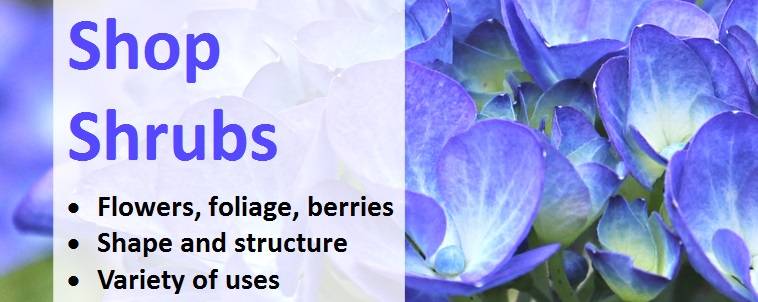Simple Planting Guide
Timing
Container grown plants – any time of the year but remember that autumn is best because the soil is naturally moist but not waterlogged, the sun is not too strong and critically, if the temperatures are not too cold, plants will develop fine root hair that gives them a head start in spring.
Root balled and bare root plants- November to March but again, autumn is best.
Evergreen plants – can be the exception - sometimes it can be beneficial to plant evergreens in March and April instead of autumn as cold drying winds over winter can dehydrate the plant. In sheltered spots it is still best to plant evergreens in autumn.

Preparation
Don’t plant when the ground is frozen or waterlogged. If the ground is low lying or subject to lying wet, add soil and compost to the planting area to raise the planting hole out of the immediate waterlogged area. Thoroughly dig over the area so the planting hole isn’t isolated and the ground all around the plants is loose. This helps prevent water logging of the immediate planting hole and ensures that the plant is able to root out freely through and across the surrounding soil profile.
Planting trees and shrubs
1. Ideally soak the roots of potted and bare root plants for 4 hours prior to planting. Never allow the roots to dry out. Dig the planting hole 1 ½ times the size of the roots.
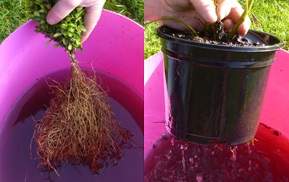
2. Mix up to half and half of the dug out soil with planting compost (multi purpose tree and shrub planting compost is fine but remember ericaceous plants need ericaceous compost instead) and sprinkle a hand full of fertilizer (blood fish and bone/bone meal) over the soil & compost and mix together.
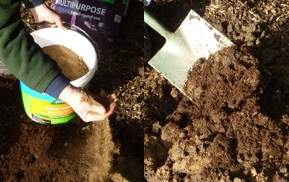
3. Plant the tree or shrub at the same depth as it was previously growing at or, up to 25mm deeper – look for the change in the colour of the stem if bare root – never plant so that the plant is too high in the hole and never push or compress the plant roots in the hole to make it fit. Make sure the plant is looking its best by rotating it in the hole to make sure that the best side is facing the direction that you will be mainly viewing from.
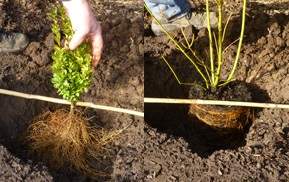
4. Backfill using the prepared mix of soil from the hole, compost and fertilizer, firming down evenly whilst ensuring that the plant is still in the upright position.
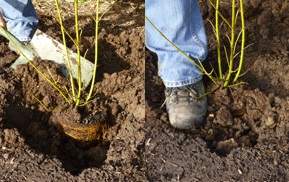
5. After planting, mulch with bark or well rotted manure and water well. Ensure that the tree or shrub is kept well watered throughout, particularly the first year following planting.
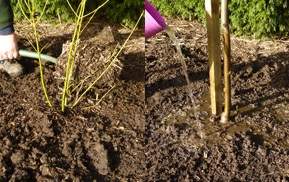
If planted early in the season or the previous autumn, carefully sprinkle a handful of the same fertilizer (taking great care to avoid the leaves) around the plant but do not feed after the end of August. In subsequent years repeat feed and mulch in April.
Additionally for trees – stake by driving a 1.5m stake firmly into the base of the planting hole before planting a bare root tree. For containerized trees drive the stake in at 45⁰to avoid damage to the roots. In either case secure using an adjustable ‘buckle’ type tie and spacer to prevent chaffing of the trunk against the post. Ensure that the tree tie is no more than 100mm from the top of the stake and that the spacer is properly set between the stake and the tree such that the tree cannot rub against the top of the stake. It’s a good idea to ensure the tree tie stays in place by knocking a small galvanised nail (felt clout ideal) through the tie into the post.Tall conifers should be staked using the 45⁰ method.
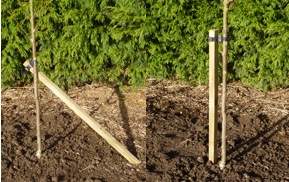
Additionally for evergreens – on a cold windy site consider planting in April instead of autumn so that the cold drying winter winds do not dry the plants out by drying all the leaves. Alternatively, evergreens could be protected by driving 3 or 4 stakes such that they are at least 500mm away from the plant and attaching a fabric windbreak to the posts to protect the full height of the plant. For root balled plants – ensure these are handled with even greater care, never drop a root balled plant. Once the root ball is in the planting hole and you are happy it is at the right depth, untie or cut the top of the root wrap and carefully tuck the sides of the root wrap under the plant. Backfill gently but firmly as not to break up the root ball.
Share this page:

